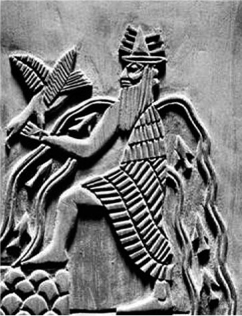Middle Eastern MythologiesSumerian Gods and Heroes |
What is an example of an important Sumerian deity myth? |
The deity myth that has attracted most attention among modern scholars is a cycle based on the deeds of the goddess Inanna, particularly the story of her descent into the Underworld. Among all Mesopotamian myths only the Gilgamesh story rivals the Inanna cycle in attention paid to it.
The first part of the Inanna story, recorded in tablets about the Huluppu Tree, in fact, involves Gilgamesh. Soon after the creation, the young Inanna took a tree from the Euphrates and carried it to her city, Uruk, hoping it would grow into her throne. But a serpent made a nest in the roots of the tree and the dark Lilith made a home in its trunk. It is inevitable that we think of other mythological trees here, including those of the Bible’s book of Genesis and the Norse Yggdrassil story.
Inanna asked the hero of Uruk, Gilgamesh, to help rid her tree of the invaders. This he did and carved a throne and a bed out of its trunk for his “holy sister.”
In a crucial meeting with the wise trickster god Enki, in which the two deities drink a great deal, Inanna succeeds in tricking her older relative into giving her the sacred me. Before Enki has time to regret his mistake, Inanna pushes away from her host’s dock in the “Boat of Heaven,” and escapes with the me, now as a deity at least equal in power to Enki. In the next segment of the cycle, which cannot help but remind us of the biblical Song of Songs, Inanna searches as the goddess of fertility for a husband to “plow” her “wet ground.” The husband will be the shepherd Dumuzi, who will fertilize the embodiment of female fertility itself, and Inanna’s “field” will provide the riches of grain and other plants.
But Inanna is not satisfied to be queen of Uruk. In order to realize her full potential as a great deity, she must understand the reality of her dark sister Ereshkigal. To do this she must descend into the world of death. Thus begins this most ancient of the archetypal descent myths. It is a story of losing the self to find the self, of dying to be reborn. It contains elements we associate with better-known descent myths such as those of the Greek Persephone, the Egyptian Osiris, and even Jesus. It involves sacrifice and apparent death and culminates in resurrection and return.

A wall carving of the Sumerian trickster god Enki. In art, Enki is often shown with symbols of a bird, a goat, and water.
